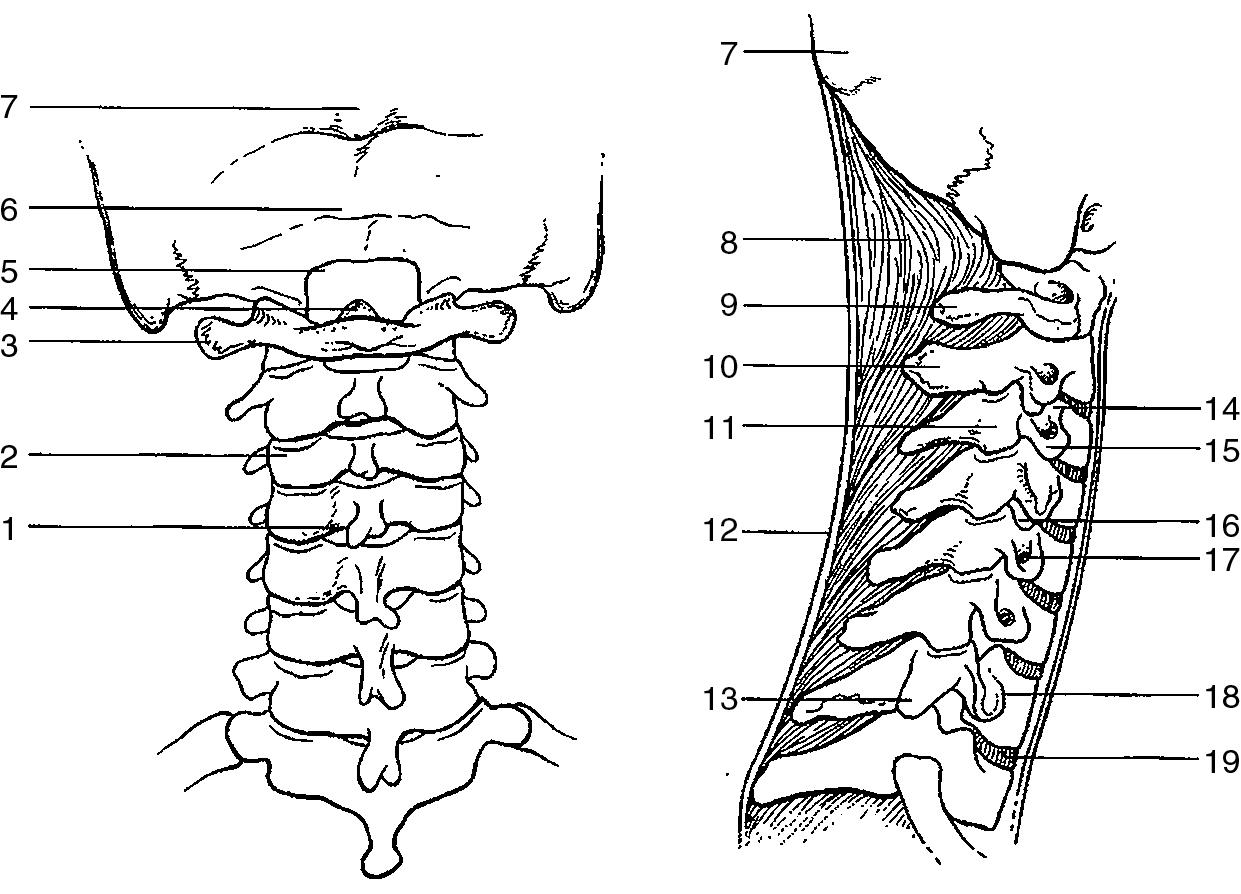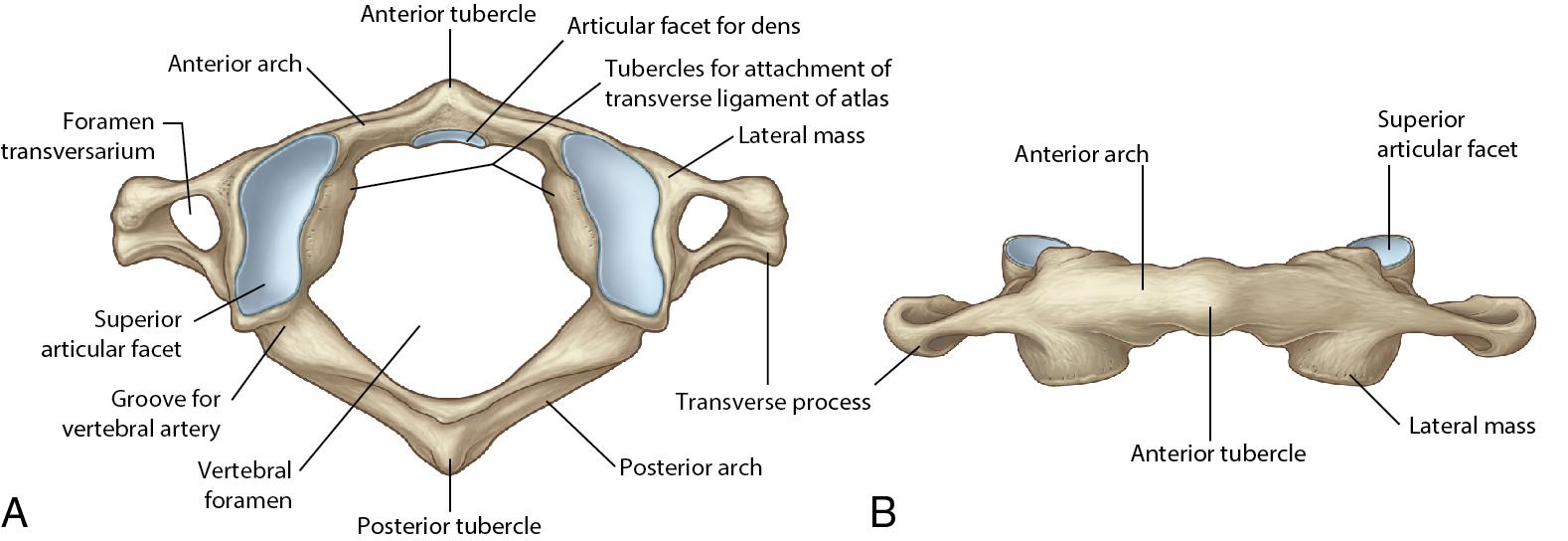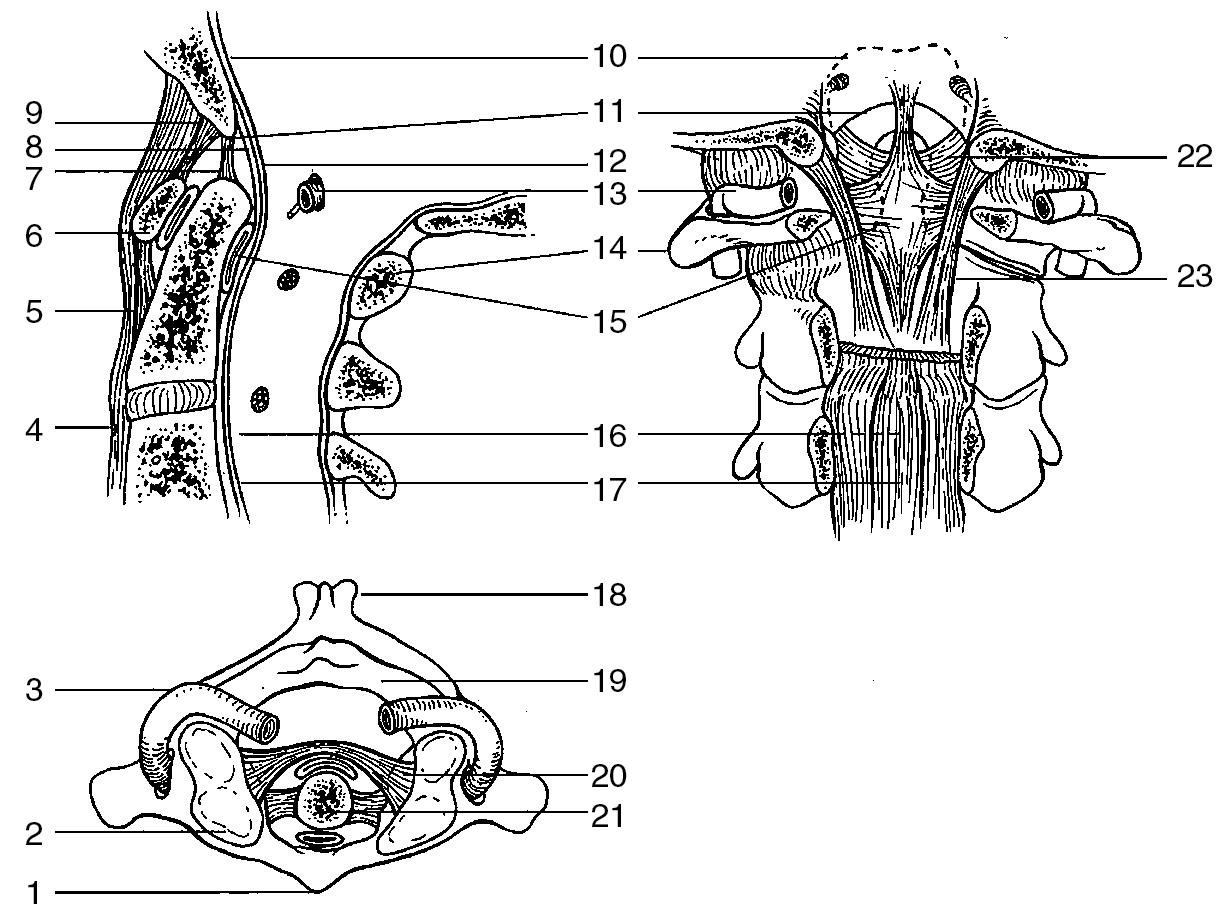Physical Address
304 North Cardinal St.
Dorchester Center, MA 02124
The occiput forms the posterior osseous covering for the cerebellum. The foramen magnum is the opening through which the spinal cord joins the brainstem. The anterior border of the foramen magnum is termed the basion (clivus), and the posterior border is termed the opisthion . The inion or external occipital protuberance is the midline region of the occiput where bone is greatest in thickness. The superior and inferior nuchal lines extend laterally and distally from the inion. The transverse sinus is located in close proximity to the inion ( Fig. 1.1 ). The area in the midline below the inion is an ideal location for screw insertion for occipital fixation as it is the thickest portion of the occiput.

C3, C4, C5, and C6 are defined as typical cervical vertebrae because they share common structural characteristics. In contrast, C1 (atlas), C2 (axis), and C7 (vertebra prominens) possess unique structural and functional features and are therefore termed atypical cervical vertebrae .
The components of a typical cervical vertebra (C3–C6) include an anterior body and a posterior arch formed by laminae and pedicles . Posteriorly, the lamina blends into the lateral mass , which comprises the bony region between the superior and inferior articular processes. The paired superior and inferior articular processes from adjacent vertebrae form the facet joint . Anteriorly, the uncovertebral (neurocentral) joints are formed by bony ridges that extend upward from the lateral margin of the superior surface of the vertebral body and articulate with a corresponding shallow concavity of the vertebra above to form the anterior border of the intervertebral foramen. The intervertebral foramina protect the exiting spinal nerves and are located behind the vertebral bodies between the pedicles of adjacent vertebrae. The transverse processes of the lower cervical spine are directed anterolaterally and composed of an anterior costal element and a posterior transverse element. The transverse foramen , located at the base of the transverse process, permits passage of the vertebral artery. The spinous process originates in the midsagittal plane at the junction of the laminae and is bifid between C2 and C6 ( Fig. 1.2 ).

The ring-like atlas (C1) is unique because during development its body fuses with the axis (C2) to form the odontoid process. Thus the atlas has no body. The atlas also lacks a spinous process. It is composed of two thick, load-bearing lateral masses, with concave superior and inferior articular facets. Connecting these facets are a relatively straight, short anterior arch and a longer, curved posterior arch. The anterior ring has an articular facet on its posterior aspect for articulation with the dens. The posterior ring has a groove on its posterior-superior surface for the vertebral artery. The weakest point of the ring is at the narrowed areas where the anterior and posterior arches connect to the lateral masses (location of a Jefferson fracture). The transverse process of the atlas has a single tubercle, which protrudes laterally and can be palpated in the space between the tip of the mastoid process and the ramus of the mandible ( Fig. 1.3 ).

The axis (C2) receives its name from its odontoid process (dens) , which forms the axis of rotation for motion through the atlantoaxial joint ( Fig. 1.4 ). The dens is a bony process extending cranially from the body of C2, formed from the embryologic body of the atlas (C1). The dens has an anterior hyaline articular surface for articulation with the anterior arch of C1, as well as a posterior articular surface for articulation with the transverse ligament. The C2 superior articular processes are located anterior and lateral to the spinal canal, while the C2 inferior articular processes are located posterior and lateral to the spinal canal. The superior and inferior articular processes on each side are connected by the pars interarticularis . Hyperflexion or hyperextension injuries may subject the axis to shear stresses, resulting in a fracture through the pars region (termed a hangman’s fracture ). The C2 pedicle is defined as that portion of the C2 vertebra connecting the posterior osseous structures with the vertebral body. This is a narrow area located between the vertebral body and the pars interarticularis. The atlantodens interval (ADI) is the space between the hyaline cartilage surfaces of the anterior tubercle of the atlas and the anterior dens. Normal adult and childhood ADI measurements are 3 mm and 5 mm, respectively.

The unique anatomic features of the C7 vertebra reflect its location as the transitional vertebra at the cervicothoracic junction:
Long, nonbifid spinous process, which provides a useful landmark
Its foramen transversarium usually contains vertebral veins but usually does not contain the vertebral artery, which generally enters the cervical spine at the C6 level
The C7 transverse process is large and possesses only a posterior tubercle
The C7 lateral mass is the thinnest lateral mass in the cervical spine
The inferior articular process of C7 is oriented in a relatively perpendicular direction (similar to a thoracic facet joint)
Facet joint orientation, bony architecture, intervertebral discs, uncovertebral joints, and ligaments all play a role in determining range of motion at various levels of the cervical spine. Approximately 50% of cervical flexion-extension occurs at the occiput–C1 level. Approximately 50% of cervical rotation occurs at the C1–C2 level. Lesser amounts of flexion-extension, rotation, and lateral bending occur segmentally between C2 and C7.
The atlanto-occipital joints are synovial joints comprised of the convex occipital condyles that articulate with the concave lateral masses of the atlas. Motion at the O–C1 segment is restricted primarily to flexion-extension due to bony and ligamentous constraints and absence of an intervertebral disc. The most important ligaments are the paired alar ligaments (extend from the tip of the dens to the medial aspect of each occipital condyle and restrict rotation of the occiput on the dens). The tectorial membrane is also important (continuous with the posterior longitudinal ligament and extends from the posterior body of C2 to the anterior foramen magnum and occiput). Less important ligaments include the anterior and posterior atlanto-occipital membrane, the O–C1 joint capsules, and the apical ligament ( Fig. 1.5 ).

Become a Clinical Tree membership for Full access and enjoy Unlimited articles
If you are a member. Log in here